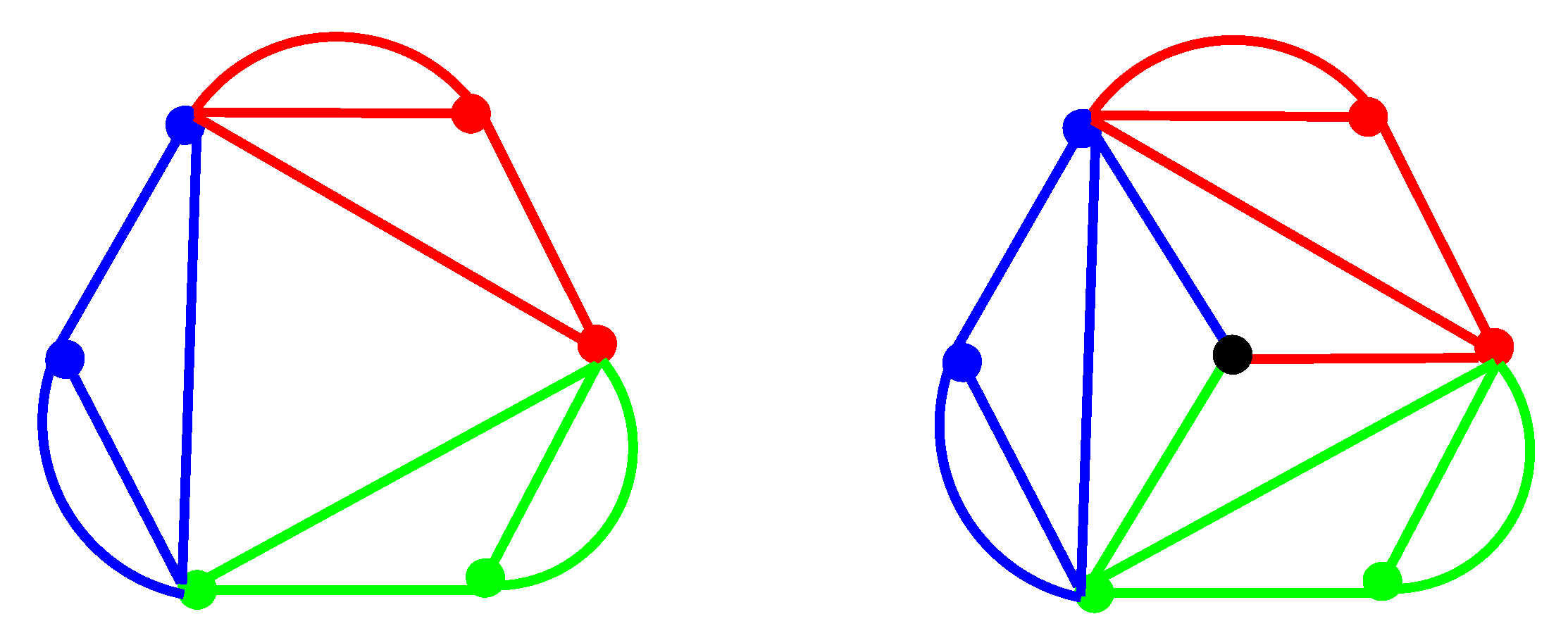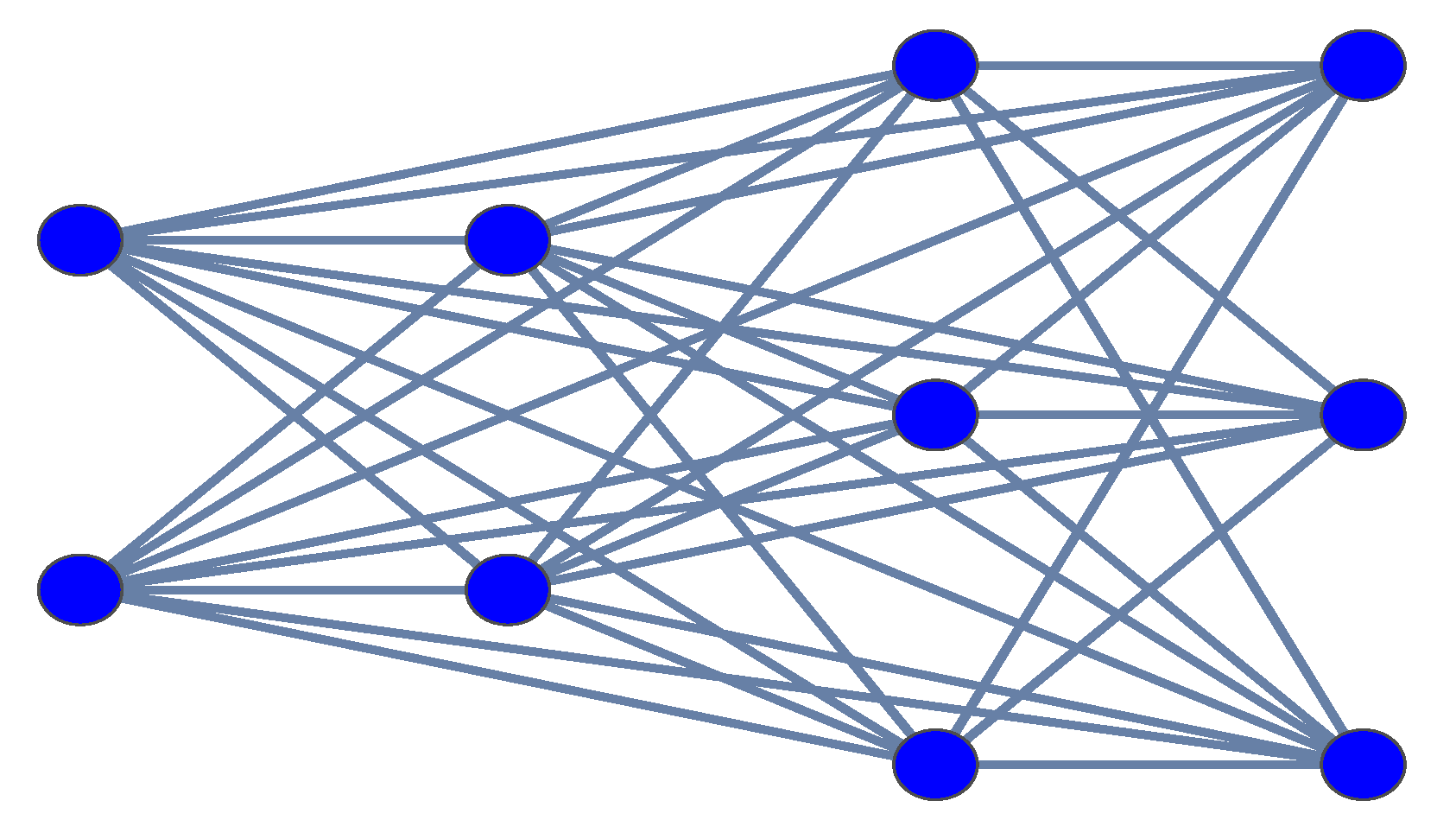1. Introduction
The purpose of this paper is to address the question of how the symmetries of a graph are reflected in its algebraic invariants. In other words, we study the interaction between the algebraic invariants of a graph and its automorphism group. Indeed, our study will be limited to discussing how the information about graph periodicity is carried by its characteristic polynomials. This question is primarily motivated by the results about knots and spatial graph periodicity obtained in terms of their quantum invariants. We shall start by fixing some notation. Let n be a positive integer and be a finite set. A weight on V is a symmetric function w: . The pair is called a weighted graph. Indeed, a weighted graph can be seen as a finite graph possibly with multiple edges and loops. In particular, if the graph is simple, then the corresponding symmetric function w is defined by if u and v are adjacent and 0 otherwise. Throughout this paper, wherever no confusion may arise, we will simplify notation and use the term graph instead of weighted graph. Given a graph with vertex set , the adjacency matrix of is the n-square matrix where . Since the weight function w is symmetric, so is the matrix . It is worth mentioning here that while the matrix depends on the ordering of the vertices, its characteristic polynomial, defined as , is known to be independent of that order. It is denoted hereafter by . On the other hand, if is the degree matrix of , which is the diagonal n-square matrix defined by , then the Laplacian matrix of is defined by . The characteristic polynomial of is also independent of the ordering of the vertices and is denoted hereafter by . Both polynomials and are well-known graph invariants which carry important information about the graph.
An automorphism of a weighted graph is a permutation of the set of vertices V such that for any pair of vertices u and v, we have . The set of all automorphisms of forms a group denoted here by .
Let be an integer. A graph is said to be p-periodic if its automorphism group contains an element h such that and for any vertex v, we have for all . In other words, the finite cyclic group acts freely on the set of vertices of the graph. A graph is said to be semi-free p-periodic if contains an element h such that and the set of fixed vertices by h is non empty. This set of fixed vertices will be denoted hereafter by F. It is worth mentioning here that for simplicity we will sometimes abuse notation and denote by F the induced subgraph as well. Notice that if is semi-free p-periodic then is p-periodic.
Let r and s be two positive integers. The complete 4-partite graph is semi-free p-periodic with fixed subgraph F the complete bipartite graph . The graph is the complete bipartite graph .
Given a
p-periodic weighted graph
, we define its quotient graph
as the weighted graph
, where
is the quotient set of
V under the action of
h and
is the weight function on
defined by
, see [
1].
The natural question of how the information about symmetries of graphs are carried by their algebraic invariants has been subject to relatively extensive study. In particular, several results about the characteristic polynomial of periodic graphs and graph coverings in general have been obtained, see [
2,
3,
4] for instance. In [
1], the first author suggested a more elementary approach by considering these polynomials with coefficients in the finite field of
p elements
. Actually, he studied the characteristic polynomial of
p-periodic graphs and proved that
is determined by the characteristic polynomial of the quotient graph
. More precisely,
. Furthermore, the polynomial
is divisible by
in
. Other necessary conditions for a graph to be
p-periodic have been also obtained in terms of the Tutte polynomial and its generalizations [
1,
5]. In this paper, we discuss the case of semi-free actions and show that some similar congruences hold.
Theorem 1. Let p be an odd prime and Γ be a semi-free p-periodic graph with a fixed subgraph F. Then the following congruences hold in Example 1. The complete 4-partite graph admits a semi-free action of , with the 4 vertices of degree 8 fixed. Hence and . Computations of the characteristic polynomials show that , and . Thus, the congruences given in Theorem 1 hold modulo 3.
Theorem 2. Let p be an odd prime and Γ be a semi-free p-periodic graph with a fixed subgraph F. Then is divisible by with quotient in .
Example 2. For the complete 4-partite graph , we have modulo 3: ; and . It can be easily checked that modulo 3. Hence, the condition given by Theorem 2 is satisfied.
2. Block Circulant Matrices
In this section we will introduce block circulant matrices and briefly explain how to compute their characteristic polynomials. More details can be found in [
6]. Let
p and
s be two positive integers. For
, let
be a
s-square matrix. The block circulant matrix
is the
-square matrix of the form:
The characteristic polynomial of the circulant matrix C, with coefficients in the finite filed , satisfies the following property.
Lemma 1. Let p be an odd prime and be a block circulant matrix. Then, .
Proof. Let
be a
primitive root of unity. For
, we define the
s-square matrix
. Let
denotes the characteristic polynomial of the matrix
. The characteristic polynomial of the circulant matrix
C is
, see [
6]. Since
p is prime, the following homomorphism is well defined:
Furthermore, it extends to a homomorphism of rings . Notice that for all we have . Thus . In conclusion, is congruent to modulo p. This completes the proof of the lemma. □
Let be a semi-free p-periodic graph with fixed set of vertices F. Assume that F is made up of r vertices . Since p is prime and is p-periodic, the finite cyclic group acts freely on the set of vertices of . This set splits into a partition made up of s orbits, where s is the number of vertices of the quotient graph . Since the action is free and p is prime, each orbit is made up of exactly p elements. Let us label the vertices of as . Let be the canonical surjection from to . We label the elements of as , so that if and . The order of the vertices of extends to a natural order of the vertices of , namely, . Notice that for all , and , we have:
- 1.
,
- 2.
.
Consequently, if we consider the order of the vertices of
obtained by placing the vertices of
F first then those of
in the order described above, then the adjacency matrix of
is of the following form:
where
denotes the adjacency matrix of the subgraph
F,
R is an
-matrix and for
,
is a
s-square matrix. Notice that the block circulant sub-matrix
is indeed the adjacency matrix of the periodic graph
. For instance the adjacency matrix of the semi-free 3-periodic graph displayed in
Figure 1 is of the form.
The adjacency matrix of the semi-free 3-periodic graph
, see
Figure 2, can be written in the form:
3. Proofs
We will first prove Theorem 1. The proof of Theorem 2 will be based on similar arguments. Let us compute the characteristic polynomial of
,
by expanding with respect to the first row. The basic observation here is that since
for
, the co-factors corresponding to each of these
p entries are equal. Hence their contribution to the value of
will add to zero modulo
p. We will prove that for the co-factors which correspond to deleting the first row of
and the columns
of
. The sub-matrices obtained by such operations will be denoted hereafter by
, respectively. These sub-matrices are displayed below.
| , , |
| …, |
where,
S is the matrix obtained from
R by deletion of the first row. Moreover, if
M is a matrix, then we denote by
the matrix obtained from
M by deletion of the first column.
Let us explain how to transform the first matrix
into
using elementary operations on rows and columns. These operations are known to keep the determinant unchanged up to a sign. First, we interchange column
and
for all
, then we apply
column interchanges to move column
to column
, our matrix is then transformed into:
|
Now, we shall rearrange rows using elementary row operations. Indeed, using
interchanges of rows we will be able to transform our matrix into:
|
By interchanging column
and column
, for
, we obtain:
|
Finally, we can perform
column operations to rearrange the matrix into the desired form:
Notice that the total number of rows and columns interchanges performed to transform
into
is
. Thus
Similarly, one can show that
, for
. It can be easily checked that
Hence, the contributions of these
p sub-matrices to the value of the determinant add to zero modulo
p. Consequently, to compute the
modulo
p, one may consider only the co-factors corresponding to entries in the first row of
F. With an elementary induction argument on the size of
F, we can prove that
modulo
p. Notice that since
is a
p-periodic graph, we have
modulo
p, as proven in [
1]. This completes the proof of Theorem 1.
The proof of Theorem 2 is also based on the study of block circulant matrices. Using the order of the vertices described above, the Laplacian matrix of
is of the form:
where
is an
r-square matrix,
M is an
-matrix and for
,
is a
s-square matrix. In a similar way, we can prove that
is the product of
by
. On the other hand, it can be easily seen that
and
coincide out of the diagonal. Furthermore, for any
i, the diagonal entries are congruent modulo
p,
modulo
p. Thus,
modulo
p. Consequently,
divides
in
.
Finally, by Lemma 1 is a polynomial on . This ends the proof of Theorem 2.





